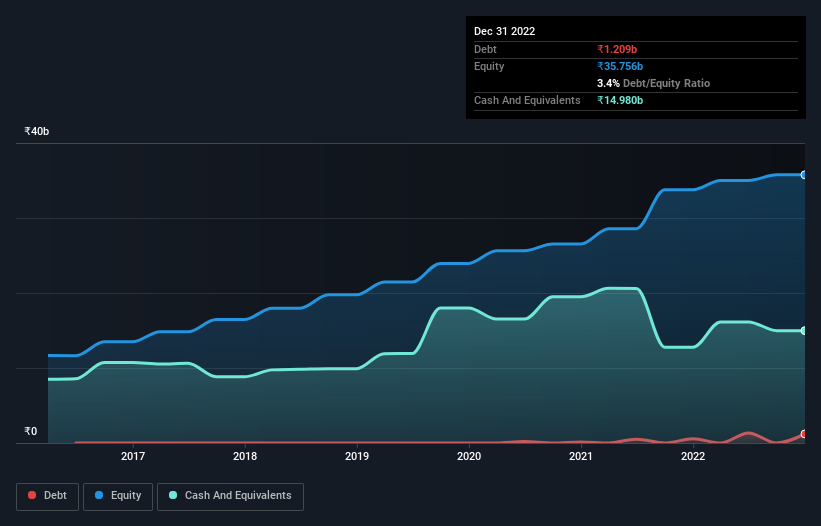- India
- /
- Consumer Durables
- /
- NSEI:WHIRLPOOL
We Think Whirlpool of India (NSE:WHIRLPOOL) Can Stay On Top Of Its Debt

Warren Buffett famously said, 'Volatility is far from synonymous with risk.' It's only natural to consider a company's balance sheet when you examine how risky it is, since debt is often involved when a business collapses. As with many other companies Whirlpool of India Limited (NSE:WHIRLPOOL) makes use of debt. But is this debt a concern to shareholders?
Why Does Debt Bring Risk?
Debt and other liabilities become risky for a business when it cannot easily fulfill those obligations, either with free cash flow or by raising capital at an attractive price. In the worst case scenario, a company can go bankrupt if it cannot pay its creditors. While that is not too common, we often do see indebted companies permanently diluting shareholders because lenders force them to raise capital at a distressed price. Of course, debt can be an important tool in businesses, particularly capital heavy businesses. The first step when considering a company's debt levels is to consider its cash and debt together.
Check out our latest analysis for Whirlpool of India
How Much Debt Does Whirlpool of India Carry?
The image below, which you can click on for greater detail, shows that at September 2022 Whirlpool of India had debt of ₹1.21b, up from ₹564.2m in one year. But on the other hand it also has ₹15.0b in cash, leading to a ₹13.8b net cash position.

How Healthy Is Whirlpool of India's Balance Sheet?
Zooming in on the latest balance sheet data, we can see that Whirlpool of India had liabilities of ₹13.8b due within 12 months and liabilities of ₹4.13b due beyond that. On the other hand, it had cash of ₹15.0b and ₹2.94b worth of receivables due within a year. So these liquid assets roughly match the total liabilities.
This state of affairs indicates that Whirlpool of India's balance sheet looks quite solid, as its total liabilities are just about equal to its liquid assets. So it's very unlikely that the ₹161.1b company is short on cash, but still worth keeping an eye on the balance sheet. While it does have liabilities worth noting, Whirlpool of India also has more cash than debt, so we're pretty confident it can manage its debt safely.
It is just as well that Whirlpool of India's load is not too heavy, because its EBIT was down 28% over the last year. When a company sees its earnings tank, it can sometimes find its relationships with its lenders turn sour. When analysing debt levels, the balance sheet is the obvious place to start. But it is future earnings, more than anything, that will determine Whirlpool of India's ability to maintain a healthy balance sheet going forward. So if you want to see what the professionals think, you might find this free report on analyst profit forecasts to be interesting.
But our final consideration is also important, because a company cannot pay debt with paper profits; it needs cold hard cash. While Whirlpool of India has net cash on its balance sheet, it's still worth taking a look at its ability to convert earnings before interest and tax (EBIT) to free cash flow, to help us understand how quickly it is building (or eroding) that cash balance. Looking at the most recent three years, Whirlpool of India recorded free cash flow of 39% of its EBIT, which is weaker than we'd expect. That's not great, when it comes to paying down debt.
Summing Up
We could understand if investors are concerned about Whirlpool of India's liabilities, but we can be reassured by the fact it has has net cash of ₹13.8b. So we are not troubled with Whirlpool of India's debt use. There's no doubt that we learn most about debt from the balance sheet. However, not all investment risk resides within the balance sheet - far from it. We've identified 2 warning signs with Whirlpool of India , and understanding them should be part of your investment process.
At the end of the day, it's often better to focus on companies that are free from net debt. You can access our special list of such companies (all with a track record of profit growth). It's free.
Valuation is complex, but we're here to simplify it.
Discover if Whirlpool of India might be undervalued or overvalued with our detailed analysis, featuring fair value estimates, potential risks, dividends, insider trades, and its financial condition.
Access Free AnalysisHave feedback on this article? Concerned about the content? Get in touch with us directly. Alternatively, email editorial-team (at) simplywallst.com.
This article by Simply Wall St is general in nature. We provide commentary based on historical data and analyst forecasts only using an unbiased methodology and our articles are not intended to be financial advice. It does not constitute a recommendation to buy or sell any stock, and does not take account of your objectives, or your financial situation. We aim to bring you long-term focused analysis driven by fundamental data. Note that our analysis may not factor in the latest price-sensitive company announcements or qualitative material. Simply Wall St has no position in any stocks mentioned.
About NSEI:WHIRLPOOL
Whirlpool of India
Manufactures and markets home appliances in India and internationally.
Flawless balance sheet with proven track record.
Market Insights
Community Narratives



